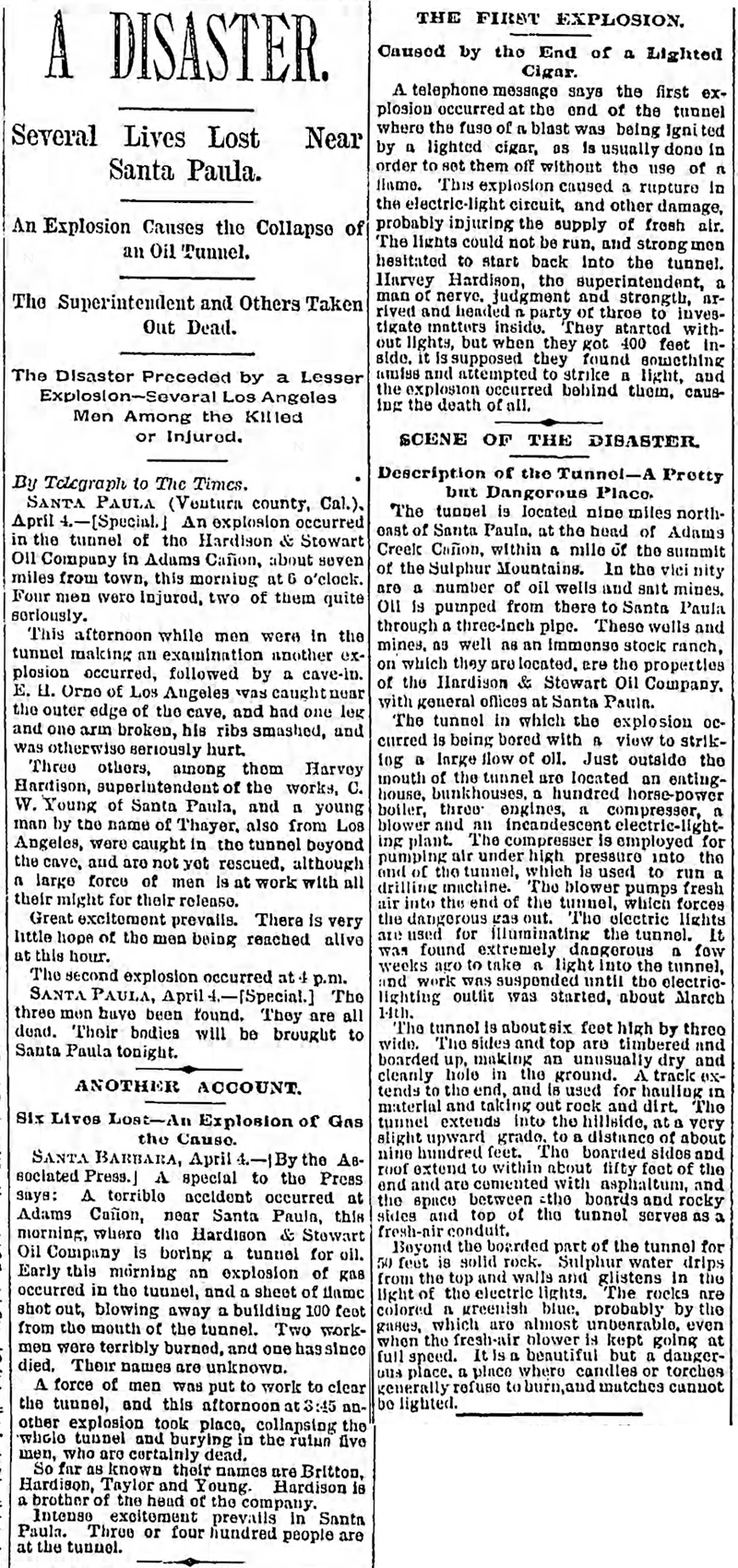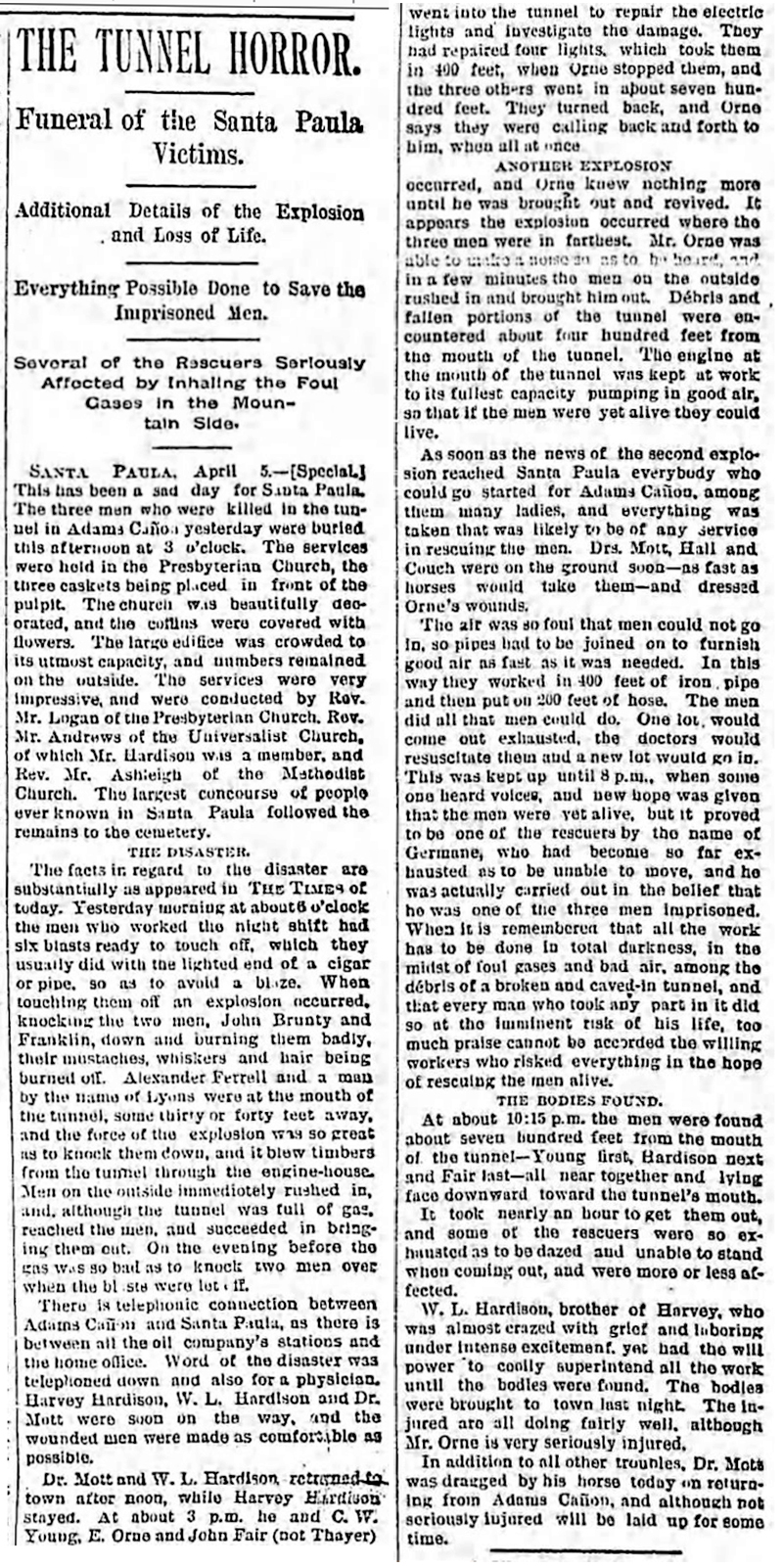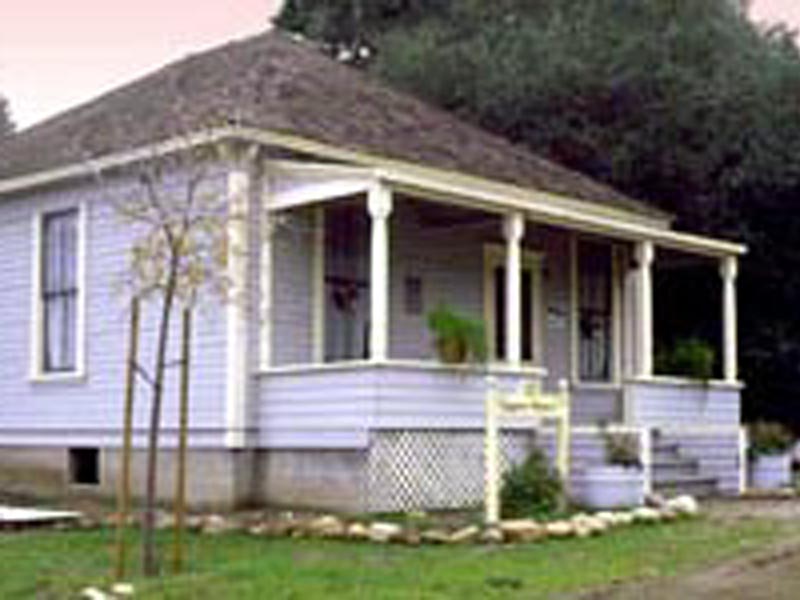|
|
Oilman Harvey Hardison Among Casualties in Fatal Tunnel Explosion.
Incident April 4, 1890 | News Reports.
|
Webmaster's note.
Harvey Hardison, featured here, was a brother of Wallace L. Hardison, who came out West in 1883 to join the Pico Canyon oil frenzy with partner Lyman Stewart. Hardison and Stewart set up a warehouse in downtown Newhall for their oil business, across Railroad Avenue from Campton's General Store, near the Newhall Depot. By 1890 the owners of the proven lands in Pico Canyon no longer wished to lease them, so Hardison and Stewart moved their operation to Santa Paula. Harvey, originally from Maine, was superintendent of the Hardison & Stewart Oil Co.; brother Wallace and Lyman Stewart were the owners. Although Harvey wouldn't live to see it, the company achieved great success, ultimately morphing into the Union Oil Co. of California.
A DISASTER.
Los Angeles Times | Saturday, April 5, 1890, pg 1.
By Telegraph to The Times.
SANTA PAULA (Ventura county, Cal.). April 4 — [Special.] An explosion occurred in the tunnel of the Hardison & Stewart Oil Company in Adams Cañon, about seven miles from town, this morning at 6 o'clock. Four men were injured, two of them quite seriously. This afternoon while men were in the tunnel making an examination, another explosion occurred, followed by a cave-in. E.H. Orne of Los Angeles was caught near the outer edge of the cave, and had one leg and one arm broken, his ribs smashed, and was otherwise seriously hurt. Three others, among them Harvey Hardison, superintendent of the works, C. W. Young of Santa Paula, and a young man by the name of Thayer, also from Los Angeles, were caught in the tunnel beyond the cave, and are not yet rescued, although a large force of men is at work with all their might for their release. Great excitement prevails. There is very little hope of the men being reached alive at this hour. The second explosion occurred at 4 p.m. SANTA PAULA, April 4. — [Special.] The three men have been found. They are all dead. Their bodies will be brought to Santa Paula tonight.
SANTA BARBARA, April 4. — [By the Associated Press.] A special to the Press says: A terrible accident occurred at Adams Cañon, near Santa Paula, this morning, where the Hardison & Stewart Oil Company is boring a tunnel for oil. Early this morning an explosion of gas occurred in the tunnel, and a sheet of flame shot out, blowing away a building 100 feet from the mouth of the tunnel. Two workmen were terribly burned, and one has since died. Their names are unknown. A force of men was put to work to clear the tunnel, and this afternoon at 3:45 another explosion took place, collapsing the whole tunnel and burying in the ruins five men, who are certainly dead. So far as known their names are Britton, Hardison, Taylor and Young. Hardison is a brother of the head of the company. Intense excitement prevails in Santa Paula. Three or four hundred people are at the tunnel.
A telephone message says the first explosion occurred at the end of the tunnel where the fuse of a blast was being ignited by a lighted cigar, as is usually done in order to set them off without the use of a flame. This explosion caused a rupture in the electric-light circuit, and other damage, probably injuring the supply of fresh air. The lights could not be run, and strong men hesitated to start back into the tunnel. Harvey Hardison, the superintendent, a man of nerve, judgment and strength, arrived and headed a party of three to investigate matters inside. They started without lights, but when they got 400 feet inside, it is supposed they found something amiss and attempted to strike a light, and the explosion occurred behind them, causing the death of all.
The tunnel is located nine miles northeast of Santa Paula, at the head of Adams Creek Cañon, within a mile of the summit of the Sulphur Mountains. In the vicinity are a number of oil wells and salt mines. Oil is pumped from there to Santa Paula through a three-inch pipe. These wells and mines, as well as an immense stock ranch, on which they are located, are the properties of the Hardison & Stewart Oil Company, with general offices at Santa Paula. The tunnel in which the explosion occurred is being bored with a view to striking a large flow of oil. Just outside the mouth of the tunnel are located an eating-house, bunkhouses, a hundred horse-power boiler, three engines, a compressor, a blower and an incandescent electric-lighting plant. The compressor is employed for pumping air under high pressure into the end of the tunnel, which is used to run a drilling machine. The blower pumps fresh air into the end of the tunnel, which forces the dangerous gas out. The electric lights are used for illuminating the tunnel. It was found extremely dangerous a few weeks ago to take a light into the tunnel, and work was suspended until the electric-lighting outfit was started, about March 14th. The tunnel is about six feet high by three wide. The sides and top are timbered and boarded up, making an unusually dry and cleanly hole in the ground. A track extends to the end, and is used for hauling in material and taking out rock and dirt. The tunnel extends into the hillside, at a very slight upward grade, to a distance of about nine hundred feet. The boarded sides and roof extend to within about fifty feet of the end and are cemented with asphaltum, and the space between the boards and rocky sides and top of the tunnel serves as a fresh-air conduit. Beyond the boarded part of the tunnel for 50 feet is solid rock. Sulphur water drips from the top and walls and glistens in the light of the electric lights. The rocks are colored a greenish blue, probably by the gases, which are almost unbearable, even when the fresh-air blower is kept going at full speed. It is a beautiful but a dangerous place, a place where candles or torches generally refuse to burn and matches cannot be lighted.
News story courtesy of Tricia Lemon Putnam.
THE TUNNEL HORROR.
Los Angeles Times | Sunday, April 6, 1890, pg 1.
SANTA PAULA, April 5. — [Special.] This has been a sad day for Santa Paula. The three men who were killed in the tunnel in Adams Cañon yesterday were buried this afternoon at 3 o'clock. The services were held in the Presbyterian Church, the three caskets being placed in front of the pulpit. The church was beautifully decorated, and the coffins were covered with flowers. The large edifice was crowded to its utmost capacity, and numbers remained on the outside. The services were very impressive, and were conducted by Rev. Mr. Logan of the Presbyterian Church, Rev. Mr. Andrews of the Universalist Church, of which Mr. Hardison was a member, and Rev. Mr. Ashleigh of the Methodist Church. The largest concourse of people ever known in Santa Paula followed the remains to the cemetery.
The facts in regard to the disaster are substantially as appeared in The Times of today. Yesterday morning at about 6 o'clock the men who worked the night shift had six blasts ready to touch off, which they usually did with the lighted end of a cigar or pipe, so as to avoid a blaze. When touching them off an explosion occurred, knocking the two men, John Brunty and Franklin, down and burning them badly, their mustaches, whiskers and hair being burned off. Alexander Ferrell and a man by the name of Lyons were at the mouth of the tunnel, some thirty or forty feet away, and the force of the explosion was so great as to knock them down, and it blew timbers from the tunnel through the engine-house. Men on the outside immediately rushed in, and, although the tunnel was full of gas, reached the men, and succeeded in bringing them out. On the evening before the gas was so bad as to knock two men over when the blasts were let off. There is a telephonic connection between Adams Cañon and Santa Paula, as there is between all the oil company's stations and the home office. Word of the disaster was telephoned down and also for a physician. Harvey Hardison, W.L. Hardison and Dr. Mott were soon on the way, and the wounded men were made as comfortable as possible. Dr. Mott and W.L. Hardison returned to town after noon, while Harvey Hardison stayed. At about 3 p.m. he and C.W. Young, E. Orne and John Fair (not Thayer) went into the tunnel to repair the electric lights and investigate the damage. They had repaired four lights, which took them in 400 feet, when Orne stopped them, and the three others went in about seven hundred feet. They turned back, and Orne says they were calling back and forth to him, when all at once
occurred, and Orne knew nothing more until he was brought out and revived. It appears the explosion occurred where the three men were in farthest. Mr. Orne was able to make a noise so as to be heard, and in a few minutes the men on the outside rushed in and brought him out. Debris and fallen portions of the tunnel were encountered about four hundred feet from the mouth of the tunnel. The engine at the mouth of the tunnel was kept at work to its fullest capacity pumping in good air, so that if the men were yet alive they could live. As soon as the news of the second explosion reached Santa Paula everybody who could go started for Adams Cañon, among them many ladies, and everything was taken that was likely to be of any service in rescuing the men. Drs. Mott, Hall and Couch were on the ground soon — as fast as horses would take them — and dressed Orne's wounds. The air was so foul that men could not go in, so pipes had to be joined on to furnish good air as fast as it was needed. In this way they worked in 400 feet of iron pipe and then put on 200 feet of hose. The men did all that men could do. One lot would come out exhausted, the doctors would resuscitate them and a new lot would go in. This was kept up until 8 p.m., when someone heard voices, and new hope was given that the men were yet alive, but it proved to be one of the rescuers by the name of Germane, who had become so far exhausted as to be unable to move, and he was actually carried out in the belief that he was one of the three men imprisoned. When it is remembered that all the work has to be done in total darkness, in the midst of foul gases and bad air, among the debris of a broken and caved-in tunnel, and that every man who took any part in it did so at the imminent risk of his life, too much praise cannot be accorded the willing workers who risked everything in the hope of rescuing the men alive.
At about 10:15 p.m. the men were found about seven hundred feet from the mouth of the tunnel — Young first, Hardison next and Fair last — all near together and lying face downward toward the tunnel's mouth. It took nearly an hour to get them out and some of the rescuers were so exhausted as to be dazed and unable to stand when coming out, and were more or less affected. W.L. Hardison, brother of Harvey, who was almost crazed with grief and laboring under intense excitement, yet had the will power to coolly superintend all the work until the bodies were found. The bodies were brought to town last night. The injured are all doing fairly well, although Mr. Orne is very seriously injured. In addition to all other troubles, Dr. Mott was dragged by his horse today on returning from Adams Cañon, and although not seriously injured will be laid up for some time.
News story courtesy of Tricia Lemon Putnam.
|
Lyman Stewart
Newhall Warehouse
Harvey Hardison
Death 4/4/1890
Wallace L. Hardison
Death 4/10/1909
L.M. Hardison:
Stock Cert. 1901
Telephone Bill for Piru Ops, 1917
Alcohol Prescription for E.E. Chamberlain 1921
Stewart Residence
|
The site owner makes no assertions as to ownership of any original copyrights to digitized images. However, these images are intended for Personal or Research use only. Any other kind of use, including but not limited to commercial or scholarly publication in any medium or format, public exhibition, or use online or in a web site, may be subject to additional restrictions including but not limited to the copyrights held by parties other than the site owner. USERS ARE SOLELY RESPONSIBLE for determining the existence of such rights and for obtaining any permissions and/or paying associated fees necessary for the proposed use.









